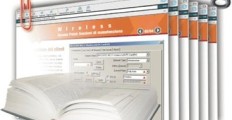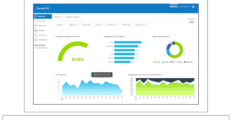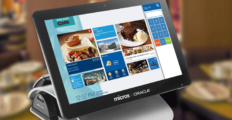mLearning or mobile learning is a type of employee learning method that uses mobile apps and devices. It empowers employees to continue learning whenever and from wherever they want.
For constantly busy employees who can’t find the time to study and train in a classroom, mlearning is a godsend. This modern technology-based learning method allows them to learn from anywhere at any time using their mobile gadgets.
Thus, it is important that businesses change their learning structures to match the current learning demand, i.e., providing the right content at the precise point of need. So, whether it involves a formal learning course or just-in-time content, this diverse mobile interaction has become the norm in today’s workplaces.
In this article, we’ll discuss what is mobile learning and how it can be useful for your employee development program. We’ll also cover relevant topics like mlearning benefits, what sets it apart from elearning, related workforce trends, and others.

How mLearning can benefit your business
Millennials overtook the Gen Xers in 2016, making them the largest workforce group in the US. They’re also the group with the highest mobile phone penetration, where 9 of 10 are smartphone owners. And with such high technology adoption, they’re the major force behind mlearning’s meteoric rise to become the preferred employee learning method.
But while millennials made mlearning popular, Gen Z will make it a must. Bred into a smartphone environment in the 2000s, the Gen Z generation will be the first truly mobile-first workforce.
This is why businesses are increasingly providing highly engaging learning approaches like mlearning to onboard and train employees. With a workforce dominated by younger generations, they’ll surely enjoy using such a familiar learning module.
A LinkedIn study says that 90% of companies nowadays offer digital learning methods. It also found that 49% of employees go for learning when it is needed, while 58% prefer the chance to have a self-directed learn pace.
How do employees prefer to learn?
Source: LinkedIn's 2018 Workplace Learning Report
Designed byLearning must be agile and self-directed
Since it’s better to retain than hire new employees, companies are prioritizing training initiatives to increase retention. A 2019 Deloitte survey found that these include the need to make learning more personal and to closely integrate work and learning. Likewise, a learning program should extend the learning ownership across the organization. Moreover, it should be able to provide solutions to day-to-day workplace challenges.
And as the need for agile, self-directed learning grows, mlearning technologies also continue to advance. For instance, the cloud-based mlearning platform Docebo is known for its capability to streamline and upgrade mobile learning efficiency. Its Go.Learn app lets your employees access your training materials and full course modules across devices. Designed to support a frictionless, continuous learning experience, the app even allows employees to continue learning even while offline.
You can check this mlearning tool when you sign up for Docebo free trial here.
On another front, wearable devices are predicted to become integrated with mobile learning apps. Furthermore, gamification and NFC technology are expected to be included to make learning enjoyable and more engaging.
Overall, these developments in mlearning indicate its expanding value to businesses and some of its upcoming trends. For companies seeking to improve their retention rates, these developments offer numerous advantages. And as learning practices and technology tools evolve, mlearning will likely sustain this transformation.

A mobile learning app’s dashboard showing its various user-friendly features and capabilities.
What is mLearning?
mlearning, like other innovations, tends to be given various definitions. However, many would agree that mobile learning is learning based on mobility, often through the use of mobile devices. These gadgets include smartphones, tablets, and wearable technology.
Another mlearning definition is that it is training content that is programmed to run on mobile gadgets. And such content is company-created ones, mostly coming from internal trainers or employees themselves.
Types and deployment modes of mLearning apps
Before deciding which mobile learning solution to use, you need to know the different kinds of mlearning solutions and the various ways to deploy them.
There are two types of mobile learning tools. First, there is performance support content that offers training materials at the point when a learner needs it. Next, there are elearning courses that are transformed for mobile solutions.
Additionally, there are two different ways to deploy mlearning apps. First is the native mobile learning apps, which basically are courses and materials for mobile platforms. A good example is Docebo’s iOS and Android apps. Second are mobile-optimized websites, which usually use an HTML-based browser to deliver mobile training. The former usually offers a more seamless experience and has an offline access option.
Difference between mLearning and eLearning
Knowing how mlearning differs from elearning is important for the learner and the company that offers the programs. And when comparing mlearning vs. elearning, various aspects come into play.
So what is the difference between elearning and mlearning? Here are some of the critical aspects that differentiate these two innovative learning technologies.
- Delivery. elearning, or electronic learning, is delivered through the Internet using electronic gadgets like laptops and desktops. On the other hand, mlearning is provided to learners via mobile or handheld devices like smartphones and tablets.
- Suitability. mlearning is best for short courses that can be viewed quickly, whereas elearning is time-bound, formal, and structured.
- Design. elearning courses are given using large-screen formats. Conversely, mlearning programs are shared using the small screens of mobile gadgets.
- Coverage. While elearning is for teaching comprehensive knowledge, mlearning is for accessing instructions at the point of need.
- Learning duration. On the one hand, mlearning offers shorter modules designed for employees with limited time to learn. Elearning has more intricate content, requires longer learning time, and targets staff with time to devote to the program.
In summary, elearning is time-bound, offered in a formal setting, and is a structured course. On the contrary, mlearning is context-aware, just-in-time, and on-demand. Both, however, are major types of LMS platforms.
Why choose mlearning?
Would complete more training in the mobile format : 100%
Would complete more training in the mobile format
100%Believe the format and presentation enhance their learning: 99%
Believe the format and presentation enhance their learning
99%Praise the convenience and time management benefits: 75%
Praise the convenience and time management benefits
75%Would pick a smartphone over a tablet or a laptop as their favorite device: 46%
Would pick a smartphone over a tablet or a laptop as their favorite device
46%Spend less time in training with no loss of compensation: 45%
Spend less time in training with no loss of compensation
45%Source: Michaels & Associates Learning Solutions
Designed byWhat are the Benefits of mLearning
Mobile learning apps are so effective that it has become one of the top three leading mobile apps. Here are some of their known benefits to businesses:
Learning flexibility
The emergence of online learning removed the need to schedule learning on an actual time and place. Mobile learning further expands this flexibility by having instructional content easily available on mobile devices, both online and offline.
Likewise, it provides learners with the flexibility of learning whenever and wherever they want. This way, employees are empowered to assume a self-directed learning process, which is known to boost learning efficiency.
Multi-device learning
A vital reason why mlearning has grown so fast is due to the convenience factor. And technology makes it possible for the same elearning courses to be available on all devices an employee might interact with daily.
Aside from the benefit of accessing course materials from PCs and laptops to tablets and smartphones, mlearning is given in bite-sized modules. So this makes it easy for employees to fit these courses even on a busy schedule.
Enhanced retention
Actual learning only occurs once a course is completed, and the main ideas are retained. Mobile learning is designed to create learner engagement, and this boosts course completion. Thus, it helps advance the learning process.
What’s more, the current workforce is primarily dominated by the younger generation. And since mlearning fits the device usage habits and learning patterns of today’s learners, the result is higher rates of retention.
Improved performance
Employees prefer learning modules that don’t interfere with their daily routines. mlearning allows learners to readily access a short course even at work.
Thus, this learning method helps create an employee learning habit that drives better performance. What’s more, you can easily monitor their progress by integrating performance appraisal software.

A clear learning direction
Most mlearning platforms are combined with phone-based learning reminders and groups. This allows learners to receive ongoing alerts and updates on their courses, from anywhere and at any time.
Moreover, learners can easily resume a course work exactly where they’ve left off. This supports learning continuity, as well as provides a definite learning path.
Online learning groups
Today’s tech-savvy workforce is mostly fond of online collaboration, usually via social media. Likewise, mobile devices have become the device of choice for accessing the internet. As such, mobile gadgets are vital to motivating learners to organize online learning communities where more effective learning can occur.
Since employee training is a critical element of business growth, encouraging mobile-based learning will inevitably help create a learning workplace culture. And to further ensure this initiative, it’s best to always be on top of the latest LMS and eLearning statistics.
Games Business Education Lifestyle Utilities Source: Statista November 2019Most popular iOS apps 2019
Games: 22.37
Business: 10.12
Education: 8.68
Lifestyle: 8.62
Utilities: 5.90
mLearning software features that enhance learning
Most mobile applications claim to offer optimum features, but in reality, only a handful of educational mobile app features can take the top over the rest. So here are the 10 most critical features that a mobile learning app must have to support learning.
Extensive and important content
Any mobile learning content should be attractive enough to quickly draw the attention of a learner. As such, your mlearning platform should be able to efficiently handle and make easily accessible broad and valuable instructional materials.
Ensure that you consider several important factors, like providing comprehensive and valuable content. Likewise, the course should run smoothly on any mobile device.
User-friendly interface
For a mobile learning app to be effective, it must have an easy-to-use, highly functional interface. This is because a well-designed dashboard boosts learning since it simplifies the process.
Meanwhile, the mlearning app you intend to use must be able to function as a learning hub. It should allow both teachers and learners to find all the courses and learning materials they need.
Developing a robust, supportive database
A well-designed, highly efficient database will boost the power of your mobile learning course. In this regard, your mlearning app should be powerful enough to handle whatever the size of your database.
A database must be regularly updated to ensure that learners can access the latest instructional materials. It should also have the capability to hold complex multimedia files.
Supports personalization
A mobile learning app must support individual learner preference and self-directed learning pace. Because every individual learner is unique, the mlearner app should provide customized training.
Aside from the learning pace, a learning platform must also deliver courses with simplified topic presentations. Moreover, test questions should be succinct and clearly framed as possible.
Interactive sessions
Nowadays, providing real-time teacher-learner interactions and live tutorials are a must. Interactive sessions are highly beneficial, with a teacher helping learners to quickly address any course issues and clarify any difficulty.
Also, offering live tutorials via a “chat now” option can create a virtual classroom setting. Moreover, these live sessions enable instructors to solicit feedback on the efficiency of the courses and the app you use.
Harnesses the power of social media
In this digital world, even employee training is affected by social media. In fact, training with your peers via social networks makes learning enjoyable and more effective.
On top of that, your mobile learning app cannot survive without the help of social media tools. For one, you can share your app’s features and course offerings via Facebook. Moreover, you can promote tutorial videos via Youtube and other video channels. Meanwhile, you can also integrate any mlearning app you use with any social media management software.
Simple login facility
A good mlearning solution should support an easy login process. Because learners can only allocate a few moments of their time to training, logging in a mobile learning tool should be a breeze.
Moreover, users must be able to create their profiles so they can quickly start or resume training. The solution should also allow users to easily select any topic they want and save their preferences.
Connect with target learners
It should be designed to reach out and integrate with the target audience. To be effective, the content must be developed with the target audience in mind.
And to allow this connection, you need to manage the flow of information using this mlearning tool capability. If you host the information on your business website, your learners can go over them using the mobile app.

Push notifications
Similar to messaging, having a push notification feature enhances the efficiency of a mobile learning app. For instance, it can keep learners updated with all important course information.
Additionally, push notifications also support information dissemination. You can even use this feature to market your learning courses within and outside your company.
Practice tests
Prepare mock tests for every chapter or section. Allowing learners to take practice tests enables them to determine if they’re prepared to take an exam or not.
Some mobile learning apps allow trainers to automate the preparation of practice tests. This way, no single practice test is the same as the previous ones, thus preventing cheating. Likewise, this feature boosts any app’s marketability.
Factors to consider when designing mLearning courses
We’ve just discussed the basics of mlearning and how you can use mobile learning apps to your benefit. And by now, you must have some working ideas on mlearning advantages and disadvantages. Additionally, you could be considering some mlearning apps to fortify your pool of talent management software.
In case you still haven’t started any in-house mlearning programs, it’s high time to do so. Meanwhile, here are important factors to consider when creating mobile learning courses for your employees:
- Type of learning content. Prepare instructional materials that are suitable for mobile consumption. Integrate images, videos, and other media if needed to enhance the learning experience.
- Screen size. Make sure your images and graphics will scale correctly on any device, and keep in mind that buttons and navigation must be big enough for learners to easily click on any device.
- Operating systems and devices. If your company already has a BYOD policy in place, ensure that your courses will run smoothly on whatever type of mobile device or OS they’ll be using.
- Internet connection. Determine if your learners will use a Wi-Fi or data connection to access the course. Perform a test run over multiple connections to know the download time and how the course runs in various Internet speeds.
- Correct authoring tool. Some elearning authoring tools are better than others when it comes to developing mobile courses.
All these factors are crucial to ensuring your mlearning courses’ success. For the last factor, you should make a shortlist of the top mlearning vendors in the market today. It’s also good practice to first try out a platform first before making a purchase decision.
Finally, in case you’d like to test drive a leading mlearning tool, you can sign up for Docebo free trial here.




























Leave a comment!